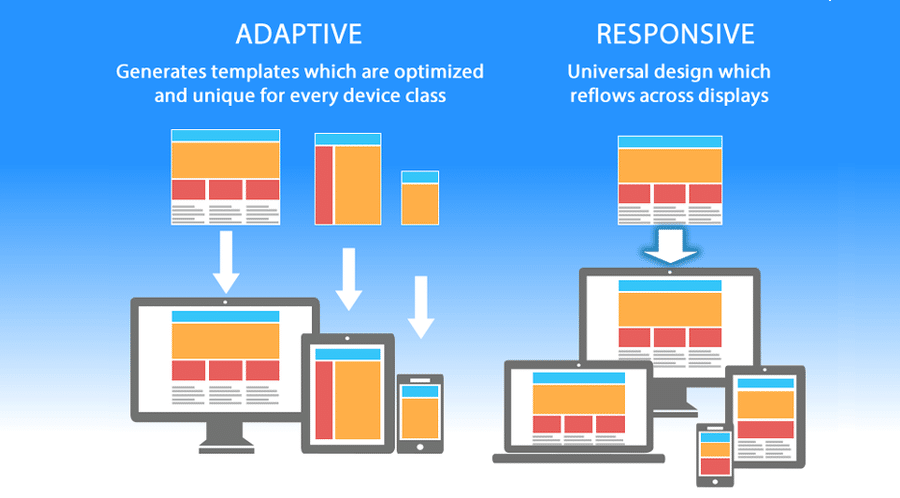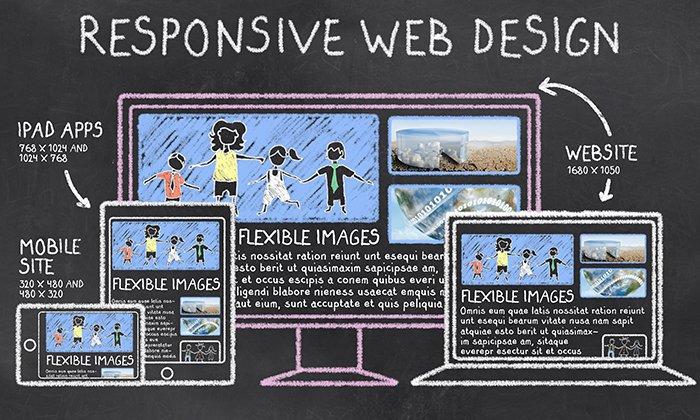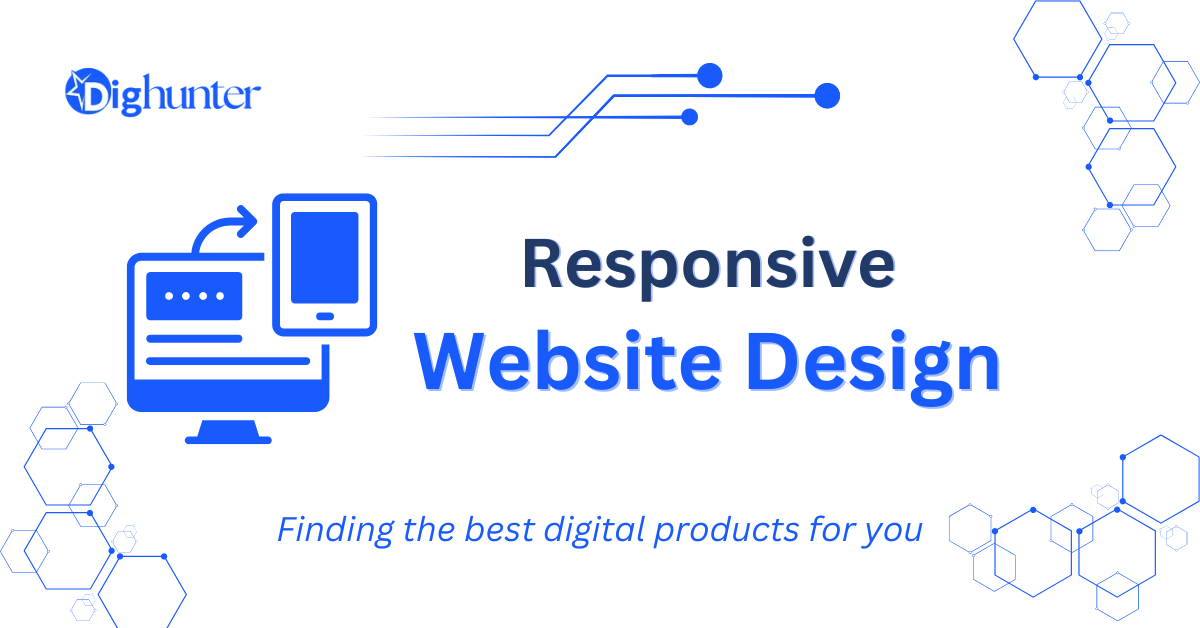Responsive Website Design (RWD) ensures websites work well on all devices. It adapts to different screen sizes for optimal viewing.
Responsive Web Design is crucial in today’s digital age. Users access websites from various devices, including smartphones, tablets, and desktops. A responsive design automatically adjusts to the screen size, providing a seamless user experience. It enhances readability, usability, and engagement, reducing bounce rates.
Search engines prioritize mobile-friendly sites, boosting SEO rankings. Businesses benefit from increased traffic and conversions. Web designers use fluid grids, flexible images, and CSS media queries to achieve responsiveness. Investing in RWD is not optional but essential. It meets user expectations and stays competitive in the ever-evolving online landscape.
➡️What Is Responsive Design
In today’s digital world, Responsive Website Design is crucial. It ensures websites look and function well on all devices. But what exactly is Responsive Design?
Key Principles
Responsive Design follows some key principles to ensure a seamless user experience across devices:
- Fluid Grids: These use percentages rather than fixed units like pixels. This ensures that elements resize proportionally.
- Flexible Images: Images scale and adjust within their containing elements. This prevents them from being too big or too small.
- Media Queries: These are CSS techniques that apply different styles based on device properties. For example, screen width or orientation.
Responsive Design also employs mobile-first design. Designers create the mobile version first, then enhance it for larger screens. This approach ensures that the website is usable on smaller screens.
Here’s a quick look at how these principles work:
| Principle | Description |
|---|---|
| Fluid Grids | Uses percentages for layout elements. |
| Flexible Images | Scales images within containing elements. |
| Media Queries | Applies styles based on device properties. |
Importance In Today’s Web
Responsive Design is essential in today’s web for several reasons:
- Increased Mobile Usage: Many users access websites from mobile devices. A responsive design ensures a good experience on all devices.
- SEO Benefits: Search engines like Google prefer responsive websites. They rank higher in search results.
- Cost-Effective: Maintaining one responsive site is cheaper than multiple versions. It saves time and resources.
- Improved User Experience: Users enjoy a seamless experience. This increases engagement and reduces bounce rates.
Responsive Design also helps in future-proofing websites. As new devices emerge, a responsive site can adapt easily. This ensures long-term usability and relevance.
In summary, Responsive Web Design is not just a trend. It’s a necessity in the modern web landscape. It offers significant benefits for both users and businesses.

Credit: www.searchenginejournal.com
➡️Benefits Of Responsive Design
Responsive Web Design ensures websites look great on all devices. This approach adapts layouts to fit various screen sizes. Let’s explore the many benefits of responsive design.
Improved User Experience
A responsive website adjusts to the user’s screen size. This means no more annoying zooming or horizontal scrolling. Users can easily read and navigate your site. Here are some key points:
- Better Readability: Text and images resize to fit the screen.
- Faster Load Times: Optimized images and layouts load quickly.
- Seamless Navigation: Menus and buttons are easy to tap on touch screens.
These features lead to a more enjoyable experience. Users stay longer on your site. This can increase engagement and reduce bounce rates. Happy users are more likely to return.
Seo Advantages
A responsive design helps your site’s search engine ranking. Google prefers mobile-friendly websites. Here are some SEO benefits:
| Benefit | Description |
|---|---|
| Single URL | One URL for all devices makes sharing and linking easier. |
| Faster Page Speed | Optimized images and code load faster, improving ranking. |
| Lower Bounce Rate | Better user experience keeps visitors on your site longer. |
With a responsive design, your site is easier to manage. You only need to maintain one website. This makes updates quicker and less expensive.
➡️Core Components
Responsive Website Design ensures your website works well on all devices. Core components like Fluid Grids and Flexible Images make this possible. Let’s explore these essential elements.
Fluid Grids
A fluid grid adapts the layout to fit different screen sizes. Unlike fixed grids, fluid grids use percentages instead of pixels.
Key benefits of fluid grids include:
- Scalability: Content adjusts smoothly across devices.
- Consistency: Users get the same experience on all screens.
- Flexibility: Developers can create versatile layouts.
Here’s a simple example of fluid grid code:
.container {
width: 100%;
display: flex;
}
.column {
width: 50%;
}
This code makes two columns that adjust with the screen size. No matter the device, the layout remains effective and user-friendly.
Flexible Images
Flexible images scale within their containing elements. They prevent images from breaking the layout.
To make images flexible, use the following CSS:
img {
max-width: 100%;
height: auto;
}
This code ensures images resize dynamically. Some advantages include:
- Consistency: Images look good on all devices.
- Performance: Faster loading times.
- Improved SEO: Better user experience enhances rankings.
Flexible images are essential for responsive designs. They keep your site looking great and performing well.
➡️Media Queries
Responsive Website Design ensures websites look good on all devices. The key to this design is Media Queries. Media Queries allow developers to apply CSS rules based on device characteristics. This ensures websites adapt to screens of different sizes and orientations.
How They Work
Media Queries are a powerful tool in CSS. They help create responsive designs. A Media Query checks the conditions of the device and applies styles accordingly.
Here’s how Media Queries work:
- Viewport Width: Media Queries can check the width of the device’s screen.
- Orientation: They can also determine if the device is in portrait or landscape mode.
- Resolution: Media Queries can check the resolution of the screen.
Media Queries use the @media rule followed by conditions. If the conditions are met, the CSS inside the Media Query is applied. Here’s a simple example:
@media (max-width: 600px) {
body {
background-color: lightblue;
}
}
This query checks if the viewport width is 600 pixels or less. If true, it changes the background color to light blue. Media Queries can also combine multiple conditions using and, or, and not.
Examples Of Use
Media Queries are versatile and can be used in many scenarios. Here are a few common examples:
- Responsive Navigation Menus: Show a different menu layout based on the screen size.
- Fluid Grid Layouts: Adjust the number of columns in a grid layout depending on the viewport width.
- Flexible Images and Media: Scale images and videos to fit different screen sizes.
Below is an example of a Media Query used for a responsive navigation menu:
@media (max-width: 768px) {
nav ul {
flex-direction: column;
}
}
This query targets devices with a maximum width of 768 pixels. It changes the navigation menu to a column layout for better readability.
Another example is using Media Queries for a fluid grid layout:
@media (min-width: 1024px) {
.grid-item {
width: 25%;
}
}
@media (max-width: 1023px) {
.grid-item {
width: 50%;
}
}
@media (max-width: 600px) {
.grid-item {
width: 100%;
}
}
In this example, the grid layout adjusts based on the screen size. It ensures the layout is always optimal for the user.
➡️Mobile-first Approach
Responsive Website Design ensures that websites look great on all devices. The Mobile-First Approach takes this a step further. It prioritizes designing for mobile devices first. This method then scales up for larger screens. This way, users get an optimal experience no matter the device.
Concept Explained
The Mobile-First Approach starts by designing the website for the smallest screen. Once the mobile version looks perfect, designers add features for larger screens. This ensures the mobile experience is not cluttered.
Key principles of the Mobile-First Approach:
- Simplicity: Start with a clean design.
- Performance: Optimize for speed on mobile networks.
- Content Priority: Show essential content first.
Designers use media queries to adjust layouts for different screens. Here’s an example of a media query:
@media (min-width: 768px) {
.container {
width: 70%;
}
}
This code increases the container width on screens wider than 768 pixels. The Mobile-First Approach ensures that every user, from smartphone to desktop, gets a tailored experience.
Benefits For Design
The Mobile-First Approach offers several benefits for design:
- Improved User Experience: Mobile users get a streamlined experience. They see only the most important content.
- Faster Load Times: Mobile designs are lightweight. This speeds up load times, especially on slower mobile networks.
- Better SEO: Search engines favor mobile-friendly sites. This can improve search rankings.
Consider this table showing the impact on user experience:
| Approach | Load Time | User Satisfaction |
|---|---|---|
| Mobile-First | Fast | High |
| Desktop-First | Slower | Lower |
By focusing on mobile users first, designers create more efficient and accessible websites. This method also simplifies the design process. Designers can focus on essential elements first. This makes the Mobile-First Approach a smart choice for modern web design.

Credit: kinsta.com
➡️Common Challenges
Responsive Web Design (RWD) is crucial for creating websites that work well on all devices. Despite its benefits, developers often face challenges. Understanding these challenges can help create better, more user-friendly websites.
Cross-device Compatibility
Cross-device compatibility ensures a website looks and works correctly on different devices. This includes desktops, tablets, and mobile phones. Achieving this is often difficult due to varying screen sizes and resolutions.
Common issues with cross-device compatibility include:
- Different screen sizes: Design must adapt to screens from 4 inches to 27 inches and beyond.
- Varying resolutions: High-resolution screens require high-quality images, which can slow down the site.
- Operating systems: Websites must work on iOS, Android, Windows, and other systems.
- Browsers: Ensuring compatibility with Chrome, Safari, Firefox, and others is essential.
Using CSS media queries is a common solution. Media queries allow developers to apply different styles based on device characteristics. Here’s a simple example:
@media (max-width: 600px) {
body {
background-color: lightblue;
}
}
This code changes the background color for screens smaller than 600 pixels. Proper testing on real devices is also important. Emulators and simulators can help, but they may not capture all user experiences.
Performance Issues
Performance issues can hinder a website’s user experience. Slow-loading pages frustrate users and increase bounce rates. Optimizing performance is vital for responsive website design.
Common performance challenges include:
- Large images: High-resolution images can slow down page load times.
- JavaScript: Heavy scripts can delay rendering, especially on mobile devices.
- CSS complexity: Complex stylesheets can increase rendering time.
- Third-party plugins: External plugins and ads can add load time.
To address these issues, developers should focus on optimization techniques. Here are some tips:
- Optimize images: Use formats like WebP, and compress images without losing quality.
- Minify CSS and JavaScript: Remove unnecessary characters to reduce file size.
- Use lazy loading: Load images and content only when they enter the viewport.
- Enable browser caching: Store static files locally to speed up subsequent visits.
Using performance analysis tools like Google PageSpeed Insights can help identify and fix issues. Regular monitoring ensures the website remains fast and efficient across all devices.
➡️Tools And Frameworks
Responsive Web Design ensures websites look good on all devices. Tools and frameworks make this process easier. They help developers create flexible and responsive websites. Let’s dive into some popular frameworks and testing tools used in responsive web design.
Popular Frameworks
Several frameworks are popular for responsive website design. These frameworks provide pre-designed templates and components. This makes it easier to create responsive websites quickly and efficiently.
Here are some of the most popular frameworks:
- Bootstrap: Bootstrap is one of the most popular frameworks. It offers a wide range of components like buttons, forms, and navigation bars. It uses a grid system to create flexible and responsive layouts.
- Foundation: Foundation is another widely used framework. It provides a range of responsive design components. It also includes a grid system and many pre-designed elements.
- Bulma: Bulma is a modern CSS framework. It is based on Flexbox, making it easy to create responsive layouts. It offers a variety of components and is easy to customize.
- Materialize: Materialize is based on Google’s Material Design. It offers a range of components that follow Material Design guidelines. It includes a grid system and many pre-designed elements.
Below is a table summarizing the key features of these frameworks:
| Framework | Grid System | Pre-designed Components | Customization |
|---|---|---|---|
| Bootstrap | Yes | Extensive | High |
| Foundation | Yes | Wide range | High |
| Bulma | Yes | Good selection | High |
| Materialize | Yes | Good selection | Medium |
Testing Tools
Testing tools are essential for responsive web design. They help ensure your website looks good on all devices. These tools allow you to test your website on various screen sizes and resolutions.
Here are some popular testing tools:
- Google Mobile-Friendly Test: This tool checks if your website is mobile-friendly. It provides suggestions for improvements. It is easy to use and provides quick results.
- BrowserStack: BrowserStack allows you to test your website on real devices. It supports a wide range of browsers and devices. It is a powerful tool for ensuring cross-browser compatibility.
- Responsinator: Responsinator shows how your website looks on different devices. It is simple to use and provides a quick overview of your website’s responsiveness.
- Screenfly: Screenfly allows you to test your website on various screen sizes. It supports desktops, tablets, and smartphones. It is a versatile tool for responsive web design testing.
Below is a table summarizing these testing tools:
| Testing Tool | Key Features | Ease of Use | Support for Devices |
|---|---|---|---|
| Google Mobile-Friendly Test | Mobile-friendly check, improvement suggestions | High | Limited |
| BrowserStack | Real device testing, cross-browser compatibility | Medium | Wide range |
| Responsinator | Device view, quick overview | High | Medium |
| Screenfly | Screen size testing, versatile tool | High | Wide range |

Credit: www.infront.com
➡️Future Trends
Responsive Website Design is evolving rapidly. Future trends are shaping the way websites are built. Staying ahead is crucial. Let’s dive into the emerging technologies and predicted changes.
Emerging Technologies
New technologies are influencing Responsive Website Design. These innovations bring enhanced user experiences. Here are some key technologies:
- Artificial Intelligence (AI): AI helps create personalized experiences. It adapts content based on user behavior.
- Progressive Web Apps (PWAs): PWAs offer app-like experiences on the web. They improve speed and reliability.
- Voice Search Optimization: Voice search is growing. Websites need to be optimized for voice commands.
- Virtual Reality (VR) and Augmented Reality (AR): VR and AR provide immersive experiences. They are becoming more common in web design.
Let’s look at a comparison table:
| Technology | Benefits |
|---|---|
| AI | Personalized content, better user engagement |
| PWAs | Faster loading, offline capabilities |
| Voice Search | Improved accessibility, faster queries |
| VR/AR | Enhanced interactivity, immersive experiences |
Predicted Changes
Future trends in Responsive Website Design suggest significant changes. Here are some predictions:
- Increased Mobile Usage: More users will access the web via mobile devices. Websites must be mobile-friendly.
- Smarter Content Loading: Lazy loading and intelligent caching will improve speed. This means content loads only when needed.
- Enhanced Security Measures: Security will become a top priority. HTTPS and secure coding practices will be essential.
- Focus on Accessibility: Websites will be more inclusive. Ensuring accessibility for all users will be crucial.
Here’s a simple list of anticipated changes:
- More mobile-first designs
- Advanced lazy loading techniques
- Stronger security protocols
- Greater emphasis on accessibility
Responsive Website Design will continue to evolve. Staying updated with these trends is vital. The future holds exciting possibilities.
➡️In a Nutshell
Responsive Website Design ensures that websites look great on all devices. It’s crucial for user experience and SEO. As we wrap up, let’s reflect on the key takeaways.
User Experience Matters
User experience is the heart of any website. A responsive design ensures that your site is accessible and easy to navigate on any device. This keeps users engaged and increases the time they spend on your site.
Seo Benefits
Search engines favor responsive websites. Google uses mobile-first indexing, which means it looks at the mobile version of your site first. A responsive design can improve your search engine ranking and drive more traffic to your site.
Cost-effective
Maintaining a single responsive site is more cost-effective than managing separate desktop and mobile versions. It saves time and resources in the long run, allowing you to focus on other aspects of your business.
Future-proof
Technology is always changing. A responsive design ensures your site is ready for the future. It adapts to new devices and screen sizes, providing a consistent experience for your users.
Consistency Across Devices
A responsive website offers a consistent experience across all devices. This builds trust and credibility with your audience. Users can access the same content and features, regardless of the device they use.
Increased Mobile Traffic
More people use mobile devices to browse the internet. A responsive design can help you tap into this growing audience. It ensures your site is mobile-friendly and attracts more mobile traffic.
Improved Loading Speed
Responsive websites often load faster on all devices. Faster loading times improve user experience and reduce bounce rates. This can also positively impact your search engine ranking.
Easier Maintenance
Managing one responsive site is simpler and more efficient. It reduces the time spent on updates and maintenance. This allows you to focus on improving your content and services.
Better Analytics
With a single responsive site, you can get better insights into your website analytics. It’s easier to track user behavior and make data-driven decisions to improve your site.
Enhanced Social Sharing
A responsive design makes it easier for users to share content across social media platforms. This can increase your site’s visibility and drive more traffic.
Responsive Web Design is essential for any modern website. It improves user experience, SEO, and ensures your site is future-proof.
➡️Frequently Asked Questions
What Is Responsive Website Design?
Responsive web design ensures websites look good on all devices. It adapts to different screen sizes. This improves user experience and accessibility.
Why Is Responsive Website Design Important?
Responsive design is crucial for user experience. It ensures your site looks great on all devices. This boosts engagement and reduces bounce rates.
How Does Responsive Website Design Work?
Responsive design uses flexible grids and layouts. It employs media queries to adapt to various screen sizes. This ensures a consistent user experience.
What Are The Benefits Of Responsive Design?
Responsive design improves SEO and user experience. It increases mobile traffic and reduces maintenance costs. It also boosts site accessibility.
➡️Final Thought
Responsive website design is essential for user experience and SEO. It ensures your site looks great on any device. By adopting responsive design, you cater to all users, improve engagement, and boost search rankings. Stay ahead by making your website accessible and user-friendly, driving success for your online presence.




